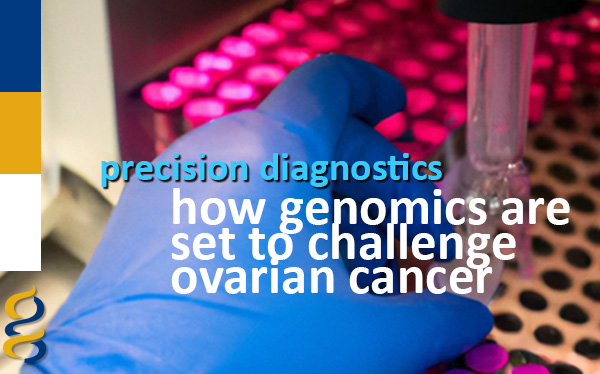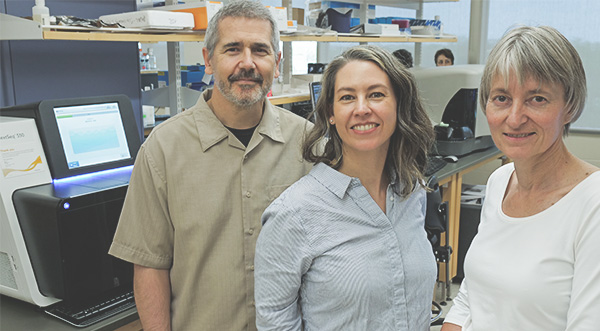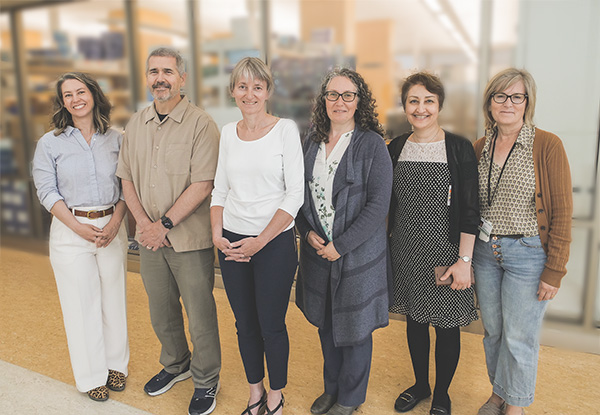
Often difficult to treat, ovarian cancer is a leading reproductive disease among Canadian women. Now researchers at the University of Saskatchewan, the Saskatchewan Health Authority, the Saskatchewan Cancer Agency and other funding partners are collaborating to use genomics better to diagnose patients towards more effective therapies.
Every year, thousands of Canadian women receive an ovarian cancer diagnosis. Approximately 2 out of 3 will eventually die from the disease. While not the most common form of cancer affecting females (uterine and breast cancer have higher numbers), ovarian cancer is notoriously difficult to diagnose early, leading to higher mortality rates.
Once diagnosed, ovarian cancer is challenging to treat, resulting in higher mortality rates than other forms of cancer (the typical survival rate is only 50% beyond six years). It’s a huge problem not lost on Dr. Mary Kinloch, a practicing gynecological pathologist and division head of Anatomical Pathology at the Saskatchewan Health Authority. Kinloch and Dr. John DeCoteau, molecular pathologists from the University of Saskatchewan, lead the recently announced Ovarian Cancer Genomics Project, funded partly by Genome Canada under the Genomic Applications Partnership Program (GAPP). The project will begin this spring and will complete its research by 2026.
“Ovarian cancer presents at an advanced stage for the vast majority of patients, which makes it so difficult to treat,” said Kinloch, who studied at University College in Dublin, Ireland, University of Saskatchewan and, University of British Columbia. “There hasn’t been a lot of targeted therapies developed, so we’re still using harsh treatments like chemotherapy, which is like using a carpet bomb on cancer. It’s indiscriminate destruction.”
“There’s not been a lot of advancement in ovarian cancer treatment because there is a lack of genomic biomarker targets we assess when we diagnose ovarian cancer. ”
DeCoteau, who studied at the University of Saskatchewan, the University of Toronto and Harvard University, said treatment advances are limited because of ovarian cancer’s inherent complexity. “I think ovarian cancer is so difficult because of the genetics,” said DeCoteau. “There are other cancers like chronic myeloid leukemia, which have targeted therapies that revolutionized treatment, but in ovarian cancer, the genetics are much more complicated, which means optimal treatment options haven’t been discovered yet.”
To better understand the therapeutic challenges facing ovarian cancer patients, it’s essential to understand the nature of cancer. While cancer comes in a wide variety of forms and types, fundamentally, the disease occurs when the human body cell DNA is damaged. When cells are damaged, the body’s automatic response is to repair cell damage by replicating what it thinks is a fix. Most of the time, the fixes work well, and cells are repaired. Sometimes, however, the fix is slightly inaccurate, making the damage worse, resulting in cell mutations. Over time, these mutations can accelerate, resulting in rapid or cancerous cell growth.
There are many forms of this DNA repair. One, in particular, is a homologous recombination repair system, or HR. When HR functions well, it can help repair damaged DNA that affects both double-helix strands. However, there are instances where the HR repair process is defective, resulting in homologous recombination deficiency, or HR-deficient .
“This project is looking at the most efficient way to use genomics techniques in real-time in the lab to identify women with either HR-deficient or HR-proficient tumours more accurately,” said DeCoteau.

The Ovarian Cancer Genomics Project includes (from l-r) Dr. John DeCoteau (academic lead), Mary Kinloch (receptor lead) and Dr. Laura Hopkins (gynecological oncologist). Photo: Daniel Hallen.
Patients categorized as HR-deficient produce proteins called Poly (ADP-ribose) polymerase, or PARPs, which help to repair damaged cells (or cells under attack). PARPs are an obstacle for patients because they repair mutations (or cancer cells). Limiting the effectiveness of PARPs running to the aid of identified cancer cells means those “HR-deficient” patients have a better chance of beating the disease.
“There are a variety of real-time lab genomic techniques used as companion diagnostics, so we can take a complicated genomics test, apply it to tumours and say with confidence that a particular woman has an HR-deficient tumour that will likely respond well to PARP inhibitors,” said DeCoteau.
“About 50% of ovarian cancer patients are HR-deficient, an important target for cancer therapy. What’s exciting is new drugs called PARP inhibitors are quite effective against ovarian cancers that arise from that pathway.”
“When you have a cell that’s a tumour cell, you kind of want that cell to commit suicide because it’s constantly repairing the damage. So, it just keeps trucking along, and we’re like, just die already,” said Kinloch.
“When you use a PARP inhibitor, it helps to push that cancer cell towards suicide.”
While PARP inhibitors offer a source of hope, it’s complicated because identifying those patients as HR-deficient isn’t straightforward. A key marker of HR-deficient patients is the presence of BRCA mutation (BReast CAncer gene). Patients who don’t have the BRCA mutation are thought not to have difficulty in PARP repair system, meaning their prognosis is less optimistic and their treatments harsher (like chemotherapy and more toxic immunotherapy).
“There’s an unfortunate group of women that receive very toxic treatments. We’re talking about the indiscriminate destruction of tumours and healthy cells, which can work. Still, it also means healthy cells that line the stomach, all skin cells in the mouth, hair cells and bone marrow are all affected.
“This project aims to refine the diagnostics process further to better separate the group of women who are HR-proficient and HR-deficient ,” said Kinloch.
The presence of BRCA is a common indicator. Still, according to DeCoteau, it may not be the only indicator that a patient is HR-deficient, meaning many ovarian cancer patients could avoid more toxic treatments.
“It’s recognized now that there are 40-odd other genes in that pathway, so if you just focus on BRCA, you’re going to miss a lot of women that could benefit from PARP inhibitors,” said DeCoteau.
The advances the ovarian cancer project makes in precision diagnosis could open opportunities to develop individual patient tumour profiles, which, if made available to specialists, could lead to providing more impactful treatments.
“Currently, Saskatchewan doesn’t have a great process to document what tumours are being diagnosed and their tumour profile,” said Kinloch. “Without that precise information, it’s difficult to make future data-driven decisions about population-based cancer care.
“One of the complicating factors is we currently compile information about patient tumours on a flat database which is just information. For this project, every patient we sequence will have a discrete data field, so everything will be relational instead of having a flat database.
“This is crucial because we can then understand how many are HR-deficient , how many are not, which mutations did they show, and, most importantly, how was their outcome. We have three years to show how having discrete data fields will provide better information and improve healthcare decisions. We want to extend this to other cancers, then.”
Those other cancers could include both prostate and breast cancer. Over 50,000 Canadians are diagnosed annually, with breast cancer being the most common among women nationwide.
“Any time researchers look for new targets, they might select a group of cancers, study their genomics and then identify new target mutations for treatment. The first important step is to have good starting materials,” said DeCoteau.
“We also intend to expand our University of Saskatchewan Cancer Biobank, which will provide us with high-quality, ethically sourced cancer specimens that are unavailable through normal clinical delivery.
“I believe the lessons we learn from this project could apply to other groups and could be revolutionary for ovarian cancer and other cancer research.”


